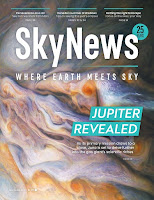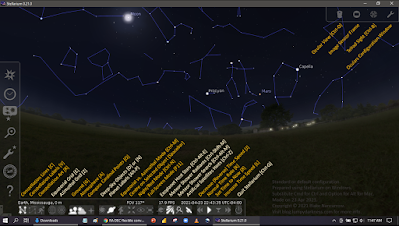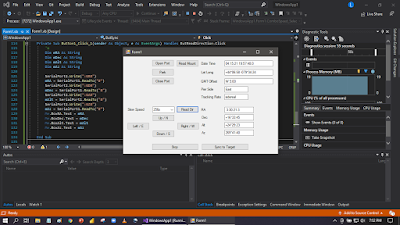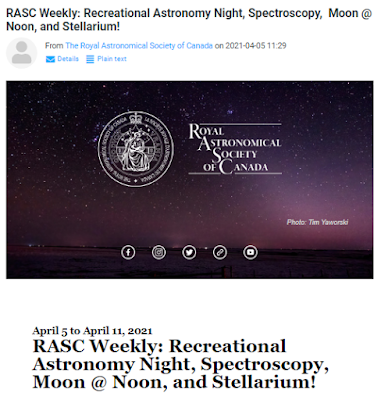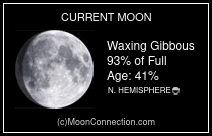Friday, April 30, 2021
sent course info
helped at talk
Thursday, April 29, 2021
searching by position
Phil S pointing out the new version no longer has Coordinates tab in the Designation Search.
Greg C set me straight. I selected any item in an observing list then followed his instructions.
- Open the Interactive Atlas chart.
- Click on the chart target in the upper left.
- Select the Coordinates tab.
Ah ha. Good stuff.
Went to my location by coordinate.
I right-clicked to create a Skymark.
Then I right-clicked to add the Skymark to my list.
Back in business.
spotted an incredible power tank
Uses a pure sine wave output, provides 500W of power, offers 550Wh, various outlets including USB-C and USB 3.0, 12V regulated DC outlets, 2 AC outlets, 6 levels of protection including under/over-voltage, over-current, over-load, short circuit, temperature, comes with a wall charger, MC4 solar adapter, vehicle cigarette charger, lightweight at 5 kg, and is relatively compact at 25x18x18 cm.
Also available at Canadian Tire.
on searching in Stellarium
He complained of many awkward steps and repeated attempts trying to entered position coordinates for stars. I asked why he was doing this. I said that most applications this is awkward. I am even irked using SkyTools. Only in Aladin have I found it to be extremely easy.
I asked for examples of the stars he was trying to find. He shared a couple and I looked them up easily, by a designation, in the main Search window. It seemed almost too easy! I must not be doing it the same way or approaching it the same way as he is. I think I don't have the full context.
He keeps referring to lists but I'm not sure exactly what that means. Is he building lists for observing campaigns. I don't think so. Is he doing research? Possibly.
It came up again a curious remark, this time written in an email. He's really struggling with the different designations for stars and seems to feel newer ones unnecessary. I explained we simply must have new catalogues for all the new discoveries. The Yale Bright Star Catalog has 9,110 stars; the Gaia telescope is cataloguing 1 billion objects.
I encouraged learning other tools like SIMBAD and Stelle Doppie to cross-reference things.
Offered to provide instructions on load more Stellarium star catalogues.
Wednesday, April 28, 2021
answered double star questions
It actually started a ways back (May 2019) with the original poster (LasVegasMikey) remarking on the confusing information from SkySafari. A screen-snap showed Mizar A and Mizar B well separated but the on-screen information on the A star showed that it was a double with 0.7" separation at a position angle of 35.9°.
There was a link to another thread explaining issues in the popular app. It referred to the the spectroscopic binary partner, Aa-Ab, as opposed to the well-known, easily-split visual double. This is still an unresolved issue in SkySafari. Makes me appreciate all the vetting done by Greg C for SkyTools.
It seemed the thread was done and dusted.
But another person (WillR) posted on 24 Apr 2021, admittedly new, and was also struggling. They did some reading and got themselves sorted. But then on 26 April, said they discovered the coordinates were wrong...
I provided a bunch of information pulling from SkySafari, SkyTools, and Stelle Doppie. Relayed the current distances and angles for the visual stars in the Mizar-Alcor system.
Still another person (clastro8*) chimed in, with a suggested edit for me, and a query about position angles.
A frequent contributor (dhkaiser) tried to help.
And I provided a diagram, at last. Picture worth a thousand bytes.
And then I clarified another question about transiting and culminating.
Hopefully I helped out people.
Monday, April 26, 2021
focused on Stellarium
Another RASC Weekly went out mentioning the Stellarium Training courses. That generated a flurry of new requests. Unfortunately I had to deflect everyone to the waiting list but it was fascinating to see another 15 or so people express interest.
Thanks for the referral!
(Some very curious form responses. Things to make you go, "Hmmm.")
In fact, we had been thinking about another date for the level 1 intro. So I pulled the trigger on that. Set a date and started pinging people from the waiting list... Growing waiting list.
I decided to take this one on. Given Ian a break. And give our candidate a chance to see another delivery style, for better or for worse.
Sent out the "prep your telescope mount" message for the level 2 participants signed up for my gig next week (a little late... oops!).
Sent out the "2 hours to go" message to the level 1 participants for this evening's course (lead by Ian B and audited by Al M).
Forwarded the event info to Al.
Received a cancellation for this course. Tried to pull someone from the waiting list but couldn't get a replacement. Oh well.
Built the new level 3 web page on the RASC Toronto Centre site. Woo! Exciting. Shared the news on the Stellarium "community" site.
Added another person to the advanced course waiting list. Nearly full already!
Refined the new boilerplate document some more... It's already proving useful.
Reached out to a past class participant struggling with searching by position. It is definitely fiddly. I found that to be the case when using the Slew telescope to window from the "Telescope Control" mount plug-in... The letters (in the RA) and symbols (in the Dec) must be included.
Minimum 18 keyboard and mouse actions; as many as 32!
Did a comparison to SkyTools. Wow. Never really thought about it but it's a boatload of steps there (including getting a chart showing).
And I learned one shouldn't hit the Spacebar. Ugh.
I also learned that you can paste in well-formed RA and Dec coords... That can be a big time-saver.
Noted a new symbol, a "target" reticule style pointer thing, in Stellarium. It appears the moment you access the Search by Position option. Captured it for the slide deck.
Debriefed with Ian after his teach.
Applied an update as per his suggestion to the intro slide deck. Add the "short" form for the course eval link. While in it, made a bunch of other edits. Consolidated changed by Ian. Also switched to a better font for the "cursive" notes in the deck, this for greater compatibility between Windows and Mac machines during delivery. And realised, that I should use a collaborative best practice so I added a Change Log slide to the end of the deck. Geez.
Uploaded my Stellarium Mobile Plus QRC draft to get Ian's eyes on it.
Liaised with Al but his ramp up process.
Processed the level 1 graduates and offered the last remaining spaces in the upcoming level 2 courses... Reviewed course evals. Invited interested parties to the Google Classroom.
Tidied up files in the instructor shared drive.
Woo! We've trained 60 people on Stellarium basics.
Re-wrote the business proposal...
submitted fourth piece
Sunday, April 25, 2021
tested a virtual room
received SkyNews May/Jun '21
I knew there was an article on Juno at Jupiter. I went straight to it to view Tanya O's processed image. Nicely done.
Chris V talked about more spring galaxies. He segued to my sketch included on the web site. Ha!
More telescope reviews. I look forward to those.
Info on eclipses too, both kinds.
Lots of amazing photography as usual.
§
See the online snippets for more info.
Saturday, April 24, 2021
delivered talk on doubles
posted Apr '21 doubles suggestion list
§
Lovely day today. Was just looking at the nearby (single) star...
The weather is improving. Clear skies are ahead. Sadly, the Moon is washing out the sky so we have to put galaxies and nebulae and faint fuzzies on hold. But double stars and variables are viable (assuming you can star hop to them).
Here’s a short selection of double and multi-star systems from my life list for your observing campaign. I found them interesting.
| star | also known as | alternate catalogue(s) |
|---|---|---|
| HD 107341 CVn | Σ1632 | SAO 62953, HIP 60161 |
| 12 Com | SHJ 143 | SAO 82273, HIP 60351 |
| HR 4363 UMa | Σ1520 | SAO 27970, HIP 55044 |
| γ (gamma) Leo | Algieba, Σ1424, 41 Leo | HIP 50583, SAO 81298 |
| 54 Vir | SHJ 151, LM Vir | SAO 157799, HIP 64520 |
Please consider adding these to your observing list. Doubles are fun, easy, sometimes challenging, interesting, colourful, and dynamic! I look forward to hearing how you did! Holler if you have any questions.
Blake Nancarrow
astronomy at computer-ease dot com
Notable double star designations:
Σ = F. Struve, STF
OΣ = O. Struve, STT
β = Burnham, BU
viewed sunspot grouping (Bradford)
Friday, April 23, 2021
loaded in wx in new BYE
Did some additional experimenting and found that additional text is tolerated inside the file... above the weather information. The last line must have the weather data.
Tested in BYE v3.2.2.
So now I have documentation and notes within, and a date/time stamp.
something completely different
I suggested trying another ethernet cable.
Gaëtan went a completely different route and recommended a computer at the telescope. Right, then remote into that...
Hold the phone.
I flashed back to 1 February 2021 when I was trying to operate the mount and camera from indoors where at the end of all my experiments I too had considered a remote computer connection.
John Gomez was already up and running so I had a look in the Start menu.
TightVNC? Check.
Stellarium? Check!
Backyard EOS. No.
Tight set up as a server? No.
So I configured Tight and remoted in from John Max. That's was working fine.
Hopped into O'Telescope and downloaded the latest Backyard EOS, 3.2.2. Registered it.
Camera was already at the workstation with tether. Connected to the camera and tested Frame & Focus. All's well.
So, without too much effort or bother, I had the necessary software installed on the laptop. With its three USB ports, ethernet port, and wifi, it can serve as the "local" computer, the computer at the telescope. It'll be interesting to try this.
And, serendipitously, it has my new Virtual Hand Controller on it!
In theory, this is ready to go.
§
Ah. That went well because I had already installed the Canon software too!
made annotated diagrams
I normally don't do this. I normally do not feel that all commands or toolbars shown with their function or action is not useful. But seeing it done elsewhere, I thought it might be beneficial or useful to some. Suit different learning styles...
And it was pretty easy to do (once I decided to not annotate in GIMP--sheesh!).
First up are the buttons in the left toolbar (mostly configuration).
Next, the bottom toolbar (mostly toggles) with descriptions and keyboard shortcuts (for Windows) shown.
I also note the Oculars toolbar at the top-right.
Enjoy.
For Stellarium 0.21.0.
Made on Windows but one can substitute Cmd for Ctrl and Option for Alt for the Mac platform.
Wednesday, April 21, 2021
helped at fun SN meeting
Tuesday, April 20, 2021
met the SPAC team
Monday, April 19, 2021
learned of next council meeting
celebrating National Volunteer Week
meeting RASC
listened to Chris and Shane's podcast
They talked about various matters but Shane then discussed his new exciting observing targets with this small refractor, double stars. And he referred to the new RASC Double Stars program! Cool! Takahashi 76mm and Panoptic and a 2-inch baader mirror diagonal.
He said he found the list to be a "ton of fun." It shows pretty doubles all over the whole sky. He "highly [recommended] it" even for people not in RASC.
The mention is between 18:25 and 21:38 in the 1 hour audio 'cast. Incredible.
Effectively, it's a review.
I'm so touched.
heard Ginny flew
Sunday, April 18, 2021
wrangled participants
Saturday, April 17, 2021
submitted photos
learned about sundials
Roger gave us a sundial tour in the French Alps, featuring the historic sundials of Zarbula and the modern dials of Remi Potey. Woody talked about how he prepared (with 700 observations) and built his reflection sundial in his man cave. And Fred (of Canada) showed incredible hybrid Peaucellier sundial designs.
I learned a lot.
Heh. Sure were a lot of grey haired white dudes...
Friday, April 16, 2021
applied more updates to VHC
Foreshortened some of the data boxes. Changed labelling around the pier data box. Added a user confirmation to the Sync button. Added system date/time display. Change Window form title. Similarly, changed the titles of all the message boxes. Relabelled the direction buttons. Up, Down, Left, etc. was redundant. Indicated Declination and Right Ascension. Renamed the position button. Fixed the left and right direction buttons. Now the left button moves to the east with increasing RA. Added code to compare the system and mount times and throw a warning if different by more than 5 minutes. Added a Tracking checkbox. Filling it turns tracking on. This will make it easy to do drifts, when needed. Or, after I issue a Stop command.
Did a bench test of the Sync button. w00t! Looks like it is working correctly. That's huge!
Made a read position code a procedure, so it wasn't buried in the read Position button. Now I called it after any release of a slew button.
Killed Visual Studio at one point. Note to self. Don't rename variables while in break mode...
I was not surprised to discover port conflicts when trying to use Stellarium and my VHC at the same time.
Not done... Re-watched Kelvin Le's video series.
Yes! Got the port selector working!
Set up a button enabler, using a trick learned in my Access VBA class!
returned to 1327 (Halifax)
Luminance only, 4 seconds subexposures, 12 stacked shots. FITS Liberator, GIMP. North is up; east is left.
Looks like good data.
Previously imaged on 5 Mar '21.
Thursday, April 15, 2021
commanded mount
Tonight I added movement buttons and was thrilled to nudge the mount! This was a major objective. I want to have a virtual hand controller on the computer to move in any direction as per a set speed. It is so amazing to see it work.
Added a big Stop button.
Added a Sync button. Another major objective. This is to be tested but if it works, it will be huge.
Hydra weirdness
If you search for Hydra, it takes you to the constellation. No mention of the other Hydra...
You can easily add this found item to the Bookmarks.
But if you go to the Hydra in the Bookmarks list, you're taken to the location of Pluto's moon Hydra!
§
I reported the error.
Wednesday, April 14, 2021
received out of focus stars
read data from the mount
Look at that! After opening the (hard coded) port, I read some data from the mount, namely its date, time, time zone offset from GMT, and the latitude and longitude. And, finally, the side of the pier I was on. I was pointed at Alphard, at the time.
Woo hoo!
This has been a bit of a journey to this point... Sadly, because of incomplete resources and people that are making assumptions.
A couple of months ago I downloaded Visual Studio 2019 Community. Had a quick look
When I went back in a week ago, it wouldn't let me proceed. At first I thought it was a trial and it had ended and that was it. But I was certain a variant of VS was free. And after some digging I confirmed it was. But Microsoft wanted some credentials. Fine.
Then I started following one tutorial on serial communications but I could not seem to reference any computer or system IO features.
Was it not possible in the free Community studio product?
I looked again at the ASCOM Telescope class and form code LXP source. Didn't make sense.
And oddly I did not find clarity in the Microsoft online docs.
Finally, a fresh Google search lead me to a post on MSDN. Leo Liu explained it. He said a Class Library using the .NET Framework was needed.
I tried that and only got so far. Some progress. But I didn't know how to get the form to work with the class object.
But another look revealed it! A Windows Form based on .NET Framework. Filtering helped! It had been there the whole time but there are so many options presented I had missed it. And all the videos I had watched had not stated that requirement!
Didn't need a Class. Not yet, anyway.
I was in business finally.
Then I watched MISperry's video on YouTube again, a joy in simplicity.
Opened the port. He showed how to write to the port. Then I read the port. And was thrilled to find the smart ReadTo method. Yes!
...
I knew it! I knew it didn't need to be so complicated! And I knew my VBA experience would be helpful. The IDE in VS sure it convoluted though, sheesh.
Tuesday, April 13, 2021
wired up a heating sheet
Sunday, April 11, 2021
updated the DS page
lovely chat
reviewed an ETU
some fixes applied
Saturday, April 10, 2021
made another diffraction mask
Wasn't keen to haul out the Celestron Optical Tube Assembly to do measurements. But then I remembered the Bahtinov mask project. So tracked down the PDF. I recalled the grating was at the exposed glass edges so I could use that as a reference... Hold the phone! I grabbed the actual focusing mask I made. I had modified it to fit inside the OTA! That would help me easily and quickly get all the measures, including the secondary mirror!
Measured the diameters.
- OTA inner diameter (ID): 22.7 cm
- opening: 20.5 cm (that seems good, an 8-inch mirror is 203 mm)
- central obstruction (CO): 70 mm
OK. Fired up Visio and located the apodisation mask I had made for the little Meade ETX.
Considered scaling up the ETX but didn't feel completely comfortable. So I started from scratch.
Like with the focusing mask, it ran off the page, too big for a single "letter" size sheet. So I cut the mask at a logical place. Printed on the laser in greyscale and cut out the pieces. Couldn't find the white glue so I used wood. It went fine.
Ready to try.
But now I'll probably have to wait 10 months... Hrrm.
another good course
helped a TSTMer
found catalogue error
Friday, April 09, 2021
goosebumps
Double star hunting has become a very pleasant observing experience! Like a good book that is so interesting one doesn't want to end but can't put it down!
This lifts me up.
found a Stellarium bug
This was happening in the latest version, 0.21.0. I also tested in 0.18.0. Same problem. Wow. So this has been around for a while.
I reported the error to the Stellarium development team on GitHub.
Told Chris.
Told the Stellarium community.
In short order Alexander Wolf replied.
The second name of beta Gemini is Hercules, so, this is not an error, but I'll add context for it.
Indeed, Pollux has an alternate name. And Castor is also known as "Apollo." OK.
I was not encouraged by his clause "I'll add context." I hope he understands that there is definitely an error in the constellation list in the search. I think we're on the right track...
Went back tto the thread and asked about the sources for star names. Alexander shared this:
Sources of the names for HIP 37826:
- Kunitzsch, P.; Smart T. (2006). "A Dictionary of Modern star Names: A Short Guide to 254 Star Names and Their Derivations" (2nd rev. ed.). Cambridge, MA: Sky Pub. ISBN 978-1-931559-44-7
- Allen, R. H. (1963). "Star Names: Their Lore and Meaning" (rep. ed.). New York, NY: Dover Publications Inc. ISBN 0-486-21079-0
- IAU Catalog of Star Names (IAU-CSN)
http://www.pas.rochester.edu/~emamajek/WGSN/IAU-CSN.txt - Jack W. Rhoads (1971). "Technical Memorandum 33-507-A Reduced Star Catalog Containing 537 Named Stars", Jet Propulsion Laboratory, California Institute of Technology; November 15, 1971
http://ntrs.nasa.gov/archive/nasa/casi.ntrs.nasa.gov/19720005197_1972005197.pdf - IAU Naming Stars
https://www.iau.org/public/themes/naming_stars/ - Bright Star Catalogue, 5th Revised Ed. (Hoffleit+, 1991)
http://vizier.u-strasbg.fr/viz-bin/VizieR?-source=V/50 - Josef Klepesta, Antonin Rukl (1977). "Constellations: A concise guide in colour". ISBN 0600008932
OK.
Then he closed the thread. Huh?
Shouldn't it be closed when the bug is stomped out?
Then Georg Zotti shared some observations.
Hercules/Apollo are listed in the BSC and Allen, the latter mentions them as being in use until Flamsteed's times. Today these names are totally out of use. We have plans to let users exclude unwanted sources from the star names, when data are complete and somebody finds time to tackle a few major tasks around skycultures.
Interesting...
So the Hercules and Apollo references are from when John Flamsteed was around, i.e. the late 1700s. We sure do need some context.
The ability for the user to control the catalogue sources could be very helpful.
This also reveals something. For years, no other bothered to test the search of all the constellations! Sheesh.
I'll watch for a fix in a future version.
Thursday, April 08, 2021
looking for B (Halifax)
So on 5 May '18, I sent the Burke-Gaffney Observatory over to have a look-see, snap! It's not definitive but there was a hint of a star, close in, to the primary. To the north-east. Perhaps. Maybe.
While working this, I went to the horse's mouth. The WDS showed a star not has dim as SkyTools alluded to, close, and about the 10 o'clock position. Huh. Maybe I was onto something... And maybe a faster exposure help.
I queued up another job at the end of last year. Half the exposure duration.
But when I checked the BGO images from 28 Dec '20, it was clear something had gone terrible wrong, with either the tracking, the stacking, or both. Sadly, all the channels were mucked up.
On 31 Mar '21 I submitted another job into the BGO robot queue. It shot the target on 9 Apr 2021 00:00:42 ADT.
No weirdness. i.e. to tracking or or problems with the stack. Not perfect, mind you, but good.
And then I noticed something weird. There is something bright at 90 degrees! And it was in all the channels...
What the heck is that?!
All images: 20 stacked shots. FITS Liberator, GIMP. North is up; east is left.
Luminance only, ½ second subexposures.
Red only, 1.5 second subexposures.
Green only, 1.5 second subexposures.
Blue only, 1.5 second subexposures.
This is very interesting. Queued up a new job right away.
Need more data...
Wednesday, April 07, 2021
shared lists
delivered my TSTM for April
Tuesday, April 06, 2021
shared some good news
shared some pix
turned up the wick
Monday, April 05, 2021
downloaded a VSP app
Stellarium registrations triggered
'Course, the triggered a little flood of messages. I'm not sure why but some landed in the EPO mailbox. Anyhoo, got a few more peeps signed up!
forwarding a serial port
If you have your laptop connected to the mount, the easiest is to forward the serial port on a TCP/IP socket on which Stellarium Plus will be able to connect.
Oh ho. Good to know.
He said that on Linux (and maybe on the Mac), one can do this just by running this command in a terminal:
socat TCP-LISTEN:10000,fork,reuseaddr FILE:/dev/ttyUSB0,b9600,raw,echo=0
Then the user would tell SMP to connect to the laptop IP on port 10000.
no free version for you
There is no free version on iOS. We are adjusting the price regularly. The iOS price might well go slightly up in the future.
Good to know. So not my imagination. There's no free, stripped down, limited version of Stellarium, like Stellarium Mobile (without the Plus) on the Android platform.
Sunday, April 04, 2021
recreated the search problem
He even sent an example, which I tried, but I did not get errors or problems.
But today, it happened!
In Stellarium (the latest version 0.21.0 no less), I was searching for something. A rather common double star. 54 Leonis.
I noticed that if I typed "54 leo" (without the quotes of course), if I typed it fully and quickly, I saw * 54 Leo (with an asterisk) in the search results list. And when I hit Enter or selected the item, I went to an unknown star! Scant details in the object information display. Weird.
So I tried again. But I typed very slowly, pausing between each character. I typed 54, space, then "l" (lower-case L) and paused. The search results listing showed two items!
54 Leo
* 54 Leo
When I chose the first suggestion, without the asterisk, I got normal stuff! I was clearly on correct star and lots of normal data showed in the information list. Very weird.
I shared my findings with Chris. "Yes. That's what I've been talking about."
Previously Chris said it didn't matter what the SIMBAD option was in the Search window...
Neither of us understand what's happening but there's some sort of glitch in the Search window. The items marked with an asterisk appear to be things not found in a catalogue. But somehow the location is right.
Or so it seems.
I noticed when I zoomed in tight, to a very high level, the * 54 Leo marker was not on the star. It was a bit off. It seems to be tied to a location but not an actual object in a catalogue.
This creates a caution for users. When searching, certainly for common stuff, avoiding selecting items with an asterisk.
checked another ETM
Saturday, April 03, 2021
learned we can't make categories
Right now only developers can create lists for WUT tool. Theoretically we can add tool for creating custom lists of objects for WUT tool, but I see problem with unnamed stars.
Bummer.
But imagining it not possible is what got me reconsidering the Bookmarks.
made a list, in Stellarium!
helped two presenters
clarification on driver bitness
Friday, April 02, 2021
tried to connect SMP to mount
No modern wifi mount. No wifi dongle. No standard mount.
Then a little light bulb went off somewhere... I think it was when I was reading the online help for SMP and saw something about control through a network. Wait. What?
StellariumScope.
On the laptop.
With a Bluetooth connection between the phone and the laptop!
Crazy.
9:40. Wired up and started the Vixen Super Polaris supercharged with the IDEA GoToStar system (still sitting beside my workstation). One-star aligned with Aldebaran, as usual.
Uninstalled 64-bit Stellarium 0.21.0 while downloading 32-bit. Along the way, added a bookmark into the bookmark bar.
(Huh, the 21 uninstaller didn't ask about "keeping files" or not.)
Paired the phone and computer.
9:45. Installed Stell v21-32b.
The installer said it found a Stellarium folder. Uh huh.
9:49. Launched Stellarium.
Will it have previous settings, I wondered... Yep. All the active buttons and plug-ins. Star catalogue 5 loaded. But nothing in the mount profiles list.
Loaner USB at COM4.
Made a (an ASCOM) profile for the Vixen-IDEA rig. Connected.
9:56. Good slew to Betelgeuse.
OK. Stage 1 done...
10:00. StellariumScope running and configured with ASCOM.
First attempt in SMP.
Instruments menu. Turned on Telescope toggle...
Oops.
It's trying to go through the Network but the IP host is wrong. Fixed that.
10:02. Attempt 2.
No luck. I saw a "probing" message with references to NexStar and LX200 but I think that's like "direct" support on the full app.
10:04. Trying Bluetooth.
Nothing on the device scan. Sheesh.
Phone doesn't seem to want to connect to the computer...
10:10. Initiated the Pair new device on the phone again. It saw (again) the laptop. Saw the common key. And Windows show it as paired (again).
10:14. Sent a file from the laptop to the phone successfully...
10:17. But I can't seem to send a file from the phone...
Went to Receive Files on Windoze. Working now.
10:20. Laptop appeared now in phone.
But then message Connected to service failed (5/5) appeared and it disconnected.
Guess I should read the manual...
10:37. Found a Starry Night BlueStar Telescope adapter (with the NexStar cable)...
10:46. Tested with Stellarium 0.18.0 on desktop via laptop via StellariumScope work (as before).
Reset the BlueStar and paired with phone.
11:00. Cycled thru 5 times but then disconnect. I think it's looking for connected hand controller...
11:02. Plugged the BT adapter into the GoToStar. Triggered the connect on the phone. The red LED went out on the BT device. Something happening. Phone went to through the device types...
Nope.
Dang, I thought the GoToStar hand controller might answer to LX200 commands...
11:11. Tried the Intelliscope cable with the BlueStar. Nope.
Back to the network solution...
Maybe I can try one of those LX200 drivers that... kinda worked.
Activated AdvancedLX200 ASCOM driver in StellariumScope. Nope.
Oh. Tried again and watched the Staples USB-serial adapter. Lots of activity!
And the AdvancedLX driver causes all sorts of other issues...
11:35. Tried everything I can think of.
Hmm. I have an OTG cable...
§
Well. At least I got newest Stellarium correctly installed.
I keep thinking though, why is the network method looking for a type of mount? My impression from the support text is that it will just work through the network. I dunno.
tune in Wednesday
built first mobile course
Thursday, April 01, 2021
sent in next Journal piece
This one was in the can for a while, I wrote it a month or so ago. My proof-reader Rhonda was impressed: only one typo.

